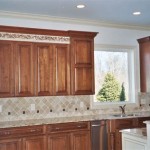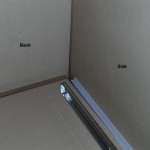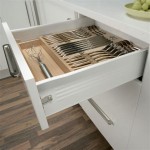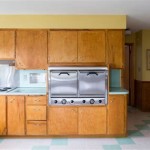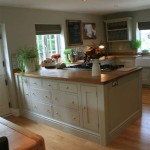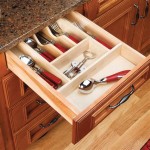Kitchen With White Cabinets And Brown Walls: A Guide to Harmonious Design
The combination of white cabinets and brown walls in a kitchen represents a classic and versatile design choice. This pairing offers a balanced aesthetic, leveraging the brightness and clean lines of white with the warmth and grounding effect of brown. The success of this design hinges on understanding the nuances of color theory, material selection, and the specific styles of kitchens that best accommodate this palette.
White cabinets are a perennial favorite in kitchen design for several reasons. They reflect light effectively, making the space feel larger and more open. They also provide a neutral backdrop that allows other elements, such as countertops, backsplashes, and hardware, to take center stage. Furthermore, white is a timeless color that transcends trends, ensuring a lasting appeal. Brown walls, on the other hand, contribute a sense of warmth and comfort. Brown is an earthy color that evokes feelings of stability and security, making it a welcoming choice for a space where people gather and spend significant time.
The interplay between white and brown can be further refined by considering the specific shades and undertones of each color. For example, a bright, crisp white will create a more modern and minimalist look, while an off-white or cream will lend a more traditional and cozy feel. Similarly, brown can range from light tan and beige to deep chocolate and espresso. The choice of brown will significantly impact the overall ambiance of the kitchen, with lighter browns creating a brighter and airier space and darker browns adding depth and sophistication.
Understanding the Appeal of White Cabinets and Brown Walls
The enduring popularity of white cabinets and brown walls stems from its inherent advantages in creating a balanced and visually appealing kitchen environment. The contrast between the two colors provides visual interest without being overwhelming. The neutrality of white allows for flexibility in incorporating other colors and textures through accessories, appliances, and décor. Brown walls, by grounding the space, prevent the kitchen from feeling too sterile or clinical, a common concern when using predominantly white surfaces.
The combination is also adaptable to various kitchen styles. In a farmhouse kitchen, white shaker cabinets can be paired with warm, light brown walls to create a rustic and inviting atmosphere. In a modern kitchen, sleek white cabinets can be contrasted with dark, rich brown walls to achieve a sophisticated and contemporary look. The versatility of this color scheme makes it a suitable choice for a wide range of design preferences.
Moreover, the practical benefits of this color combination should not be overlooked. White cabinets are easy to clean and maintain, and they tend to show less wear and tear than darker cabinets. Brown walls, especially in darker shades, are more forgiving of stains and smudges than lighter walls, making them a practical choice for a high-traffic area like the kitchen.
Key Considerations for Implementing the Design
Successfully integrating white cabinets and brown walls requires careful consideration of several factors, including lighting, material selection, and the overall style of the kitchen. The amount of natural light available in the space will significantly impact the choice of white and brown shades. In a poorly lit kitchen, lighter shades of both colors are preferable to maximize brightness and create a more open feel. In a kitchen with ample natural light, darker shades can be used to create a more dramatic and sophisticated look.
The choice of materials for the cabinets, countertops, and flooring is also crucial. White cabinets can be made from various materials, including wood, laminate, and metal. The material will affect the overall look and feel of the kitchen. For example, wood cabinets will add warmth and texture, while metal cabinets will create a more modern and industrial aesthetic. Similarly, the choice of countertop material will influence the overall design. Granite, quartz, and marble are popular choices for white cabinets, as they offer a range of colors and patterns that complement the white finish.
The flooring should also be carefully considered to complement the white cabinets and brown walls. Hardwood floors in a medium to dark brown tone are a classic choice that adds warmth and sophistication to the kitchen. Tile flooring in a neutral color, such as beige or gray, can also be used to create a clean and modern look.
Enhancing the Aesthetic Through Accents and Details
Once the foundation of white cabinets and brown walls is established, the details and accents become instrumental in shaping the overall aesthetic. Hardware choices, backsplash design, and decorative elements can elevate the kitchen from simple to stunning. The hardware on the white cabinets should be chosen to complement the brown walls and the overall style of the kitchen. For example, brushed nickel or stainless steel hardware will create a modern and sleek look, while oil-rubbed bronze or antique brass hardware will add a touch of warmth and vintage charm.
The backsplash provides an opportunity to introduce color, texture, and pattern into the kitchen. A neutral-colored backsplash in a textured material, such as subway tile or natural stone, can add subtle visual interest without overwhelming the space. Alternatively, a bold-colored backsplash can be used to create a focal point and add personality to the kitchen. Glass tiles, mosaic tiles, and patterned tiles are all popular choices for backsplashes.
Decorative elements, such as artwork, plants, and accessories, can further enhance the aesthetic of the kitchen. A colorful piece of artwork can add visual interest and tie together the different colors in the space. Potted plants can bring life and freshness to the kitchen, while decorative accessories, such as vases, bowls, and canisters, can add personality and style.
Lighting, beyond the natural light considered previously, plays a critical role in shaping the mood and functionality of the kitchen. Under-cabinet lighting is essential for illuminating countertops and work surfaces, while pendant lights can add visual interest and create a focal point above the island or dining table. Recessed lighting can provide general illumination and highlight specific features of the kitchen. The type and placement of lighting should be carefully considered to create a well-lit and inviting space.
In summary, creating a kitchen with white cabinets and brown walls is a process that involves careful planning and attention to detail. By understanding the principles of color theory, considering the specific style of the kitchen, and selecting the right materials and accents, it is possible to create a beautiful and functional space that will be enjoyed for years to come. The key to success lies in achieving a balance between the brightness of white and the warmth of brown, creating a harmonious and inviting environment.

The Walls Are Benjamin Moore Rockies Brown Cabinets Linen Sand And Grumbacher Van Dyck Glaz Cozinhas Decoração De Casa

10 Beautiful Kitchens With Brown Walls Kitchen Remodel Small Plans Cabinets Decor

Chocolate Brown Walls White Cabinets Kitchens Paint For Kitchen Wall Colors

Painting Kitchen Cabinets White Cabinet Design Wall Colors

Brown Walls White Cabinets Kitchen Cupboard Designs Kitchens

22 Best Wall Color For Kitchen Wallcolor Popular Colors Paint Walls

Love Your Kitchen Don T Counter Mochi Home

Country Kitchen Makeover And Renovation Design Small Dining Room

White Kitchen With Dark Brown Island Transitional Kitchens Cabinets Design

Bianco Antico Granite Kitchen Design Ideas
Related Posts

